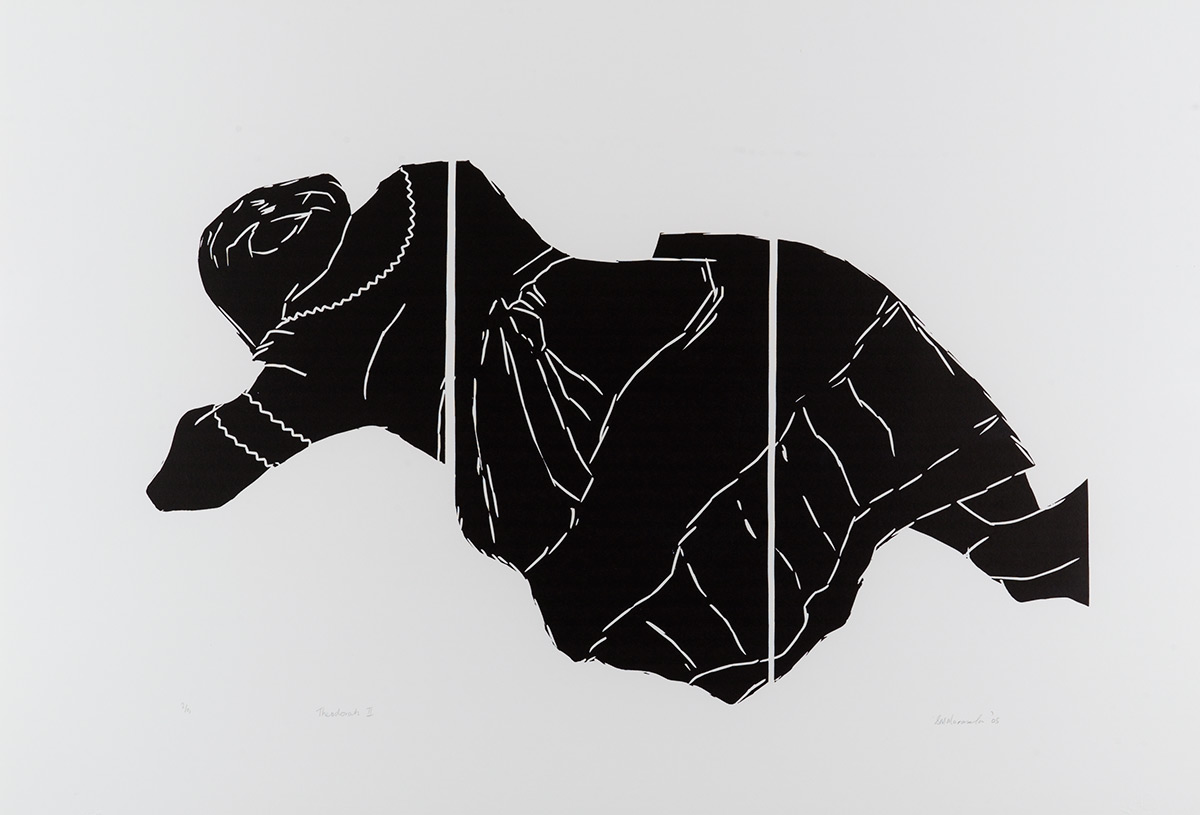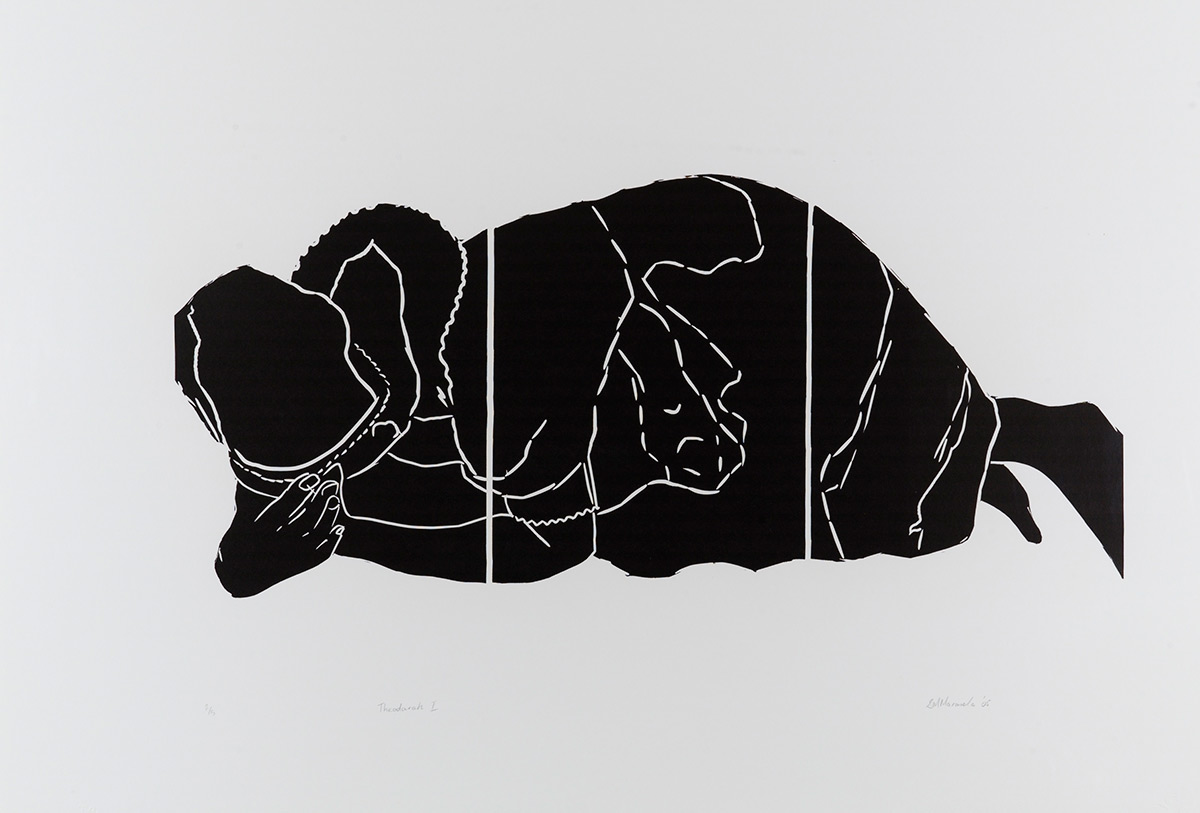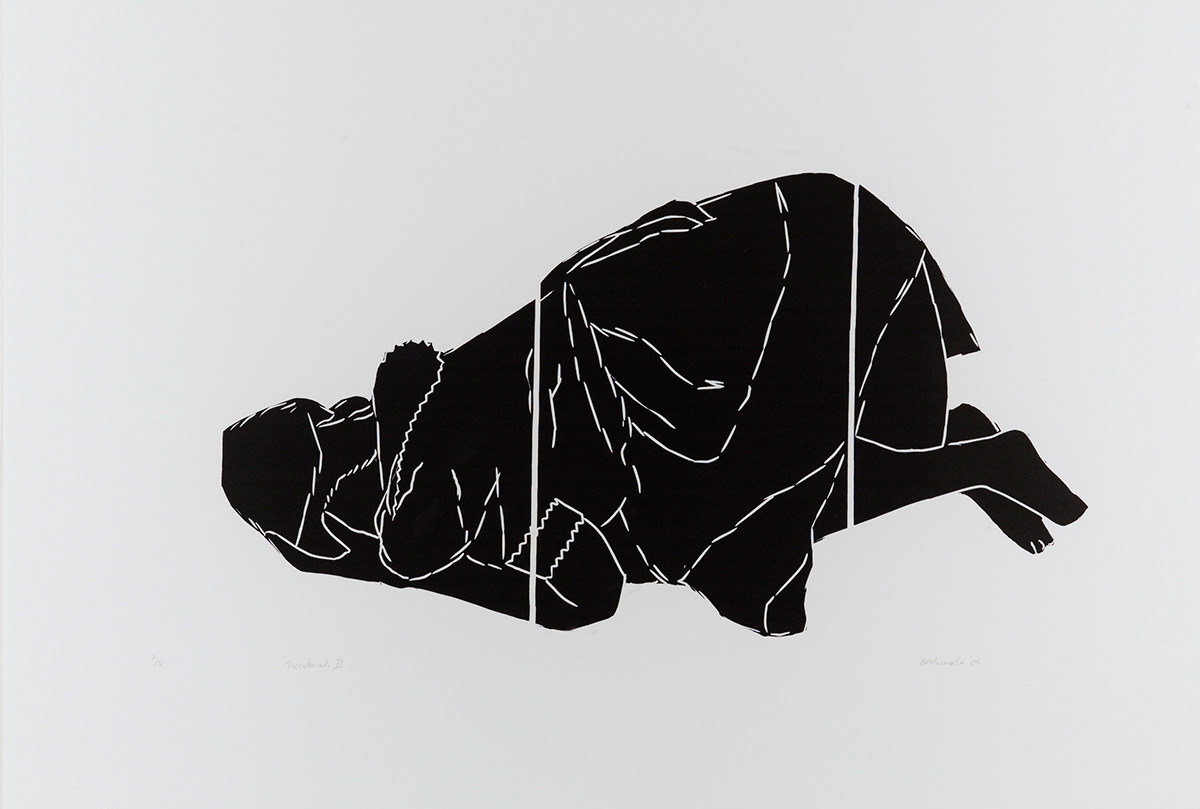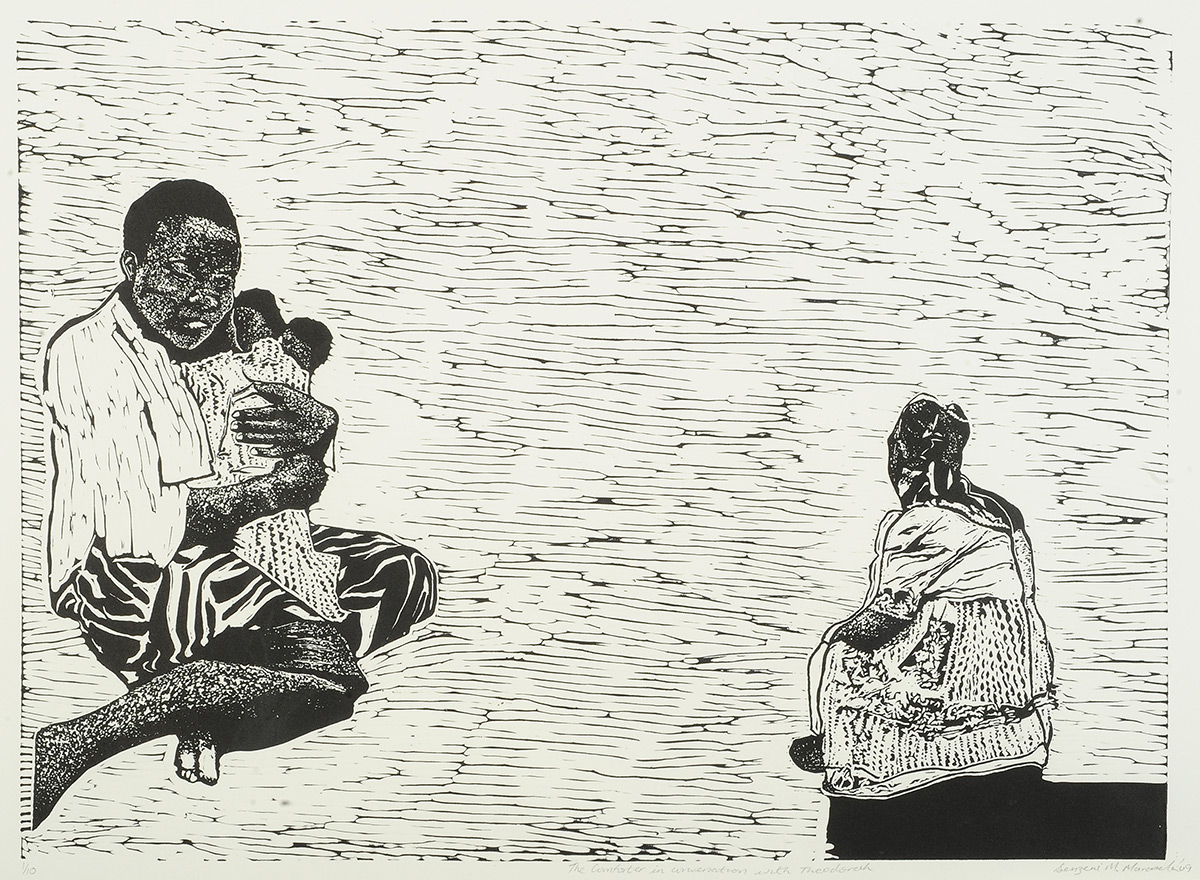Senzeni MARASELA (b. 1977)
Theodora I
2005
linocut
edition 1/5
70 x 100 cm
The figure of the woman in the linocut triptych Theodorah I, II, III is conveyed through a minimum of mark-making. Her form borders on abstraction. She seems at once to be hovering in the empty picture plain, while simultaneously holding the weight of history in her prostrated body. She lies stretched out with her face on the ground in surrender or submission, reduced to a state of exhaustion.
At the same time, it is as if she is levitating – the recognisable, everyday figure of a working-class Black woman made strange, suspended in a space and time. Her body takes on different gestures and shapes in each plain of… Continue Reading
Theodora II
2005
linocut
edition 1/5
70 x 100 cm
The figure of the woman in the linocut triptych Theodorah I, II, III is conveyed through a minimum of mark-making. Her form borders on abstraction. She seems at once to be hovering in the empty picture plain, while simultaneously holding the weight of history in her prostrated body. She lies stretched out with her face on the ground in surrender or submission, reduced to a state of exhaustion.
At the same time, it is as if she is levitating – the recognisable, everyday figure of a working-class Black woman made strange, suspended in a space and time. Her body takes on different gestures and shapes in each plain of… Continue Reading
Theodora III
2005
linocut
edition 1/5
70 x 100 cm
The figure of the woman in the linocut triptych Theodorah I, II, III is conveyed through a minimum of mark-making. Her form borders on abstraction. She seems at once to be hovering in the empty picture plain, while simultaneously holding the weight of history in her prostrated body. She lies stretched out with her face on the ground in surrender or submission, reduced to a state of exhaustion.
At the same time, it is as if she is levitating – the recognisable, everyday figure of a working-class Black woman made strange, suspended in a space and time. Her body takes on different gestures and shapes in each plain of… Continue Reading
The comforter in conversation with Theodorah
2009
linocut
edition 1/10
56 x 75,8 cm
The comforter in conversation with Theodorah is representational in style, echoing the linocut lineage wrought by some of South Africa’s central figures in printmaking, who graduated from art centres like Rorke’s Drift in northern KwaZulu-Natal, Artist Proof Studio in Johannesburg and Dakawa and Egazini in the Eastern Cape.
In this poignant depiction of the generation gap and families wrought asunder by forced migration and the politics of domestic labour, the figure of a young woman embracing a child is set in dialogue with the figure of an older woman. But there is nothing but empty space between them; the older woman’s face is turned away from both the viewer and the younger woman. It is as if she is uncontactable – far away in a distant world of her own. Far from a fantasy, this… Continue Reading
BIOGRAPHY
Born in Thokoza, Senzeni Marasela is a cross-disciplinary artist whose practice spans photography, video, printmaking and mixed-media installations involving textiles and embroidery. Her work deals with history, memory and personal narrative, emphasising historical gaps and overlooked figures.
Marasela graduated with a BA Fine Arts from the University of Witwatersrand, Johannesburg, in 1998, and shortly thereafter completed a residency at the South African National Gallery, culminating in her work for the Gallery’s Fresh exhibition series.
Marasela explores the psychogeography of Black women’s lived experiences, incorporating matrilineal stories narrated to her as a child, and wider sociocultural and political histories of South Africa. In her work, she translates memories of struggle and urbanisation through the use of material culture and narratives, such as the use of the colour red, which refers to cultural memories around the time of the ‘Red Dust’ – a period of drought in the 1930s in South Africa.
Working almost exclusively in red and using historically inscribed fabric like ishweshwe, Marasela traces both intensely personal and collective experiences of womanhood through her fictional alter ego Theodorah, who is based on her mother. Like many young black women in the city, Marasela’s mother was traumatised by events that took place during Apartheid in the 1960s.
For 16 years, beginning in 2003, Marasela inhabited her mother’s dresses as Theodorah, starting with a yellow dress, which she wore every day, to the point that her performed and actual identities became indistinguishable. Responding to its symbolic weight of the dress and the fabric as a document of history, her performance embodies and centralises the micro-histories of women in her family and the collective experience of womanhood more broadly.
‘Marasela channels the biographies of women like Sarah Baartman and Winnie Madikizela-Mandela, as well as those of fictional and mythological women like Miss Havisham (Charles Dickens’ Great Expectations, 1861) and Penelope (Homer’s Odyssey, c. eighth century BCE), to illustrate the social disregard and abandonment of these women,’ reads the text that accompanied her 2020–21 exhibition Waiting for Gebane at Zeitz Museum of Contemporary Art Africa (MOCAA).
Marasela’s work has been widely exhibited in South Africa, Europe and the United States, and features in prominent local and international collections, including the Newark Museum, Smithsonian Institution and MoMA, New York, as well as some private collections such as the Leridon Collection in Paris, the Harry David Collection in Athens and the Sindika Dokolo Collection in Angola. She was part of the 56th Johannesburg Pavilion at the Venice Biennale (2015).
Her work has been featured as part of Contemporary Women Artists of Africa (Smithsonian National Museum of African Art, Washington DC, 2019), Made Visible: Contemporary South African Fashion and Identity (Museum of Fine Arts in Boston, 2019), The Power of My Hands (Museum of Modern Art, Paris, 2021) and Witness: Afro Perspectives from the Jorge M. Pérez Collection (El Espacio 23, Miami, 2020 – 22).
Her practice has been contextualised in the following publications; Jonga: Look at Me: Museum of Women, Dolls and Memories (2009), Unbounded (2009), South African Art Now (2009), Darkroom (2009), 10 Years, 100 Artists (2005), History After Apartheid (2003), FRESH (2001).





